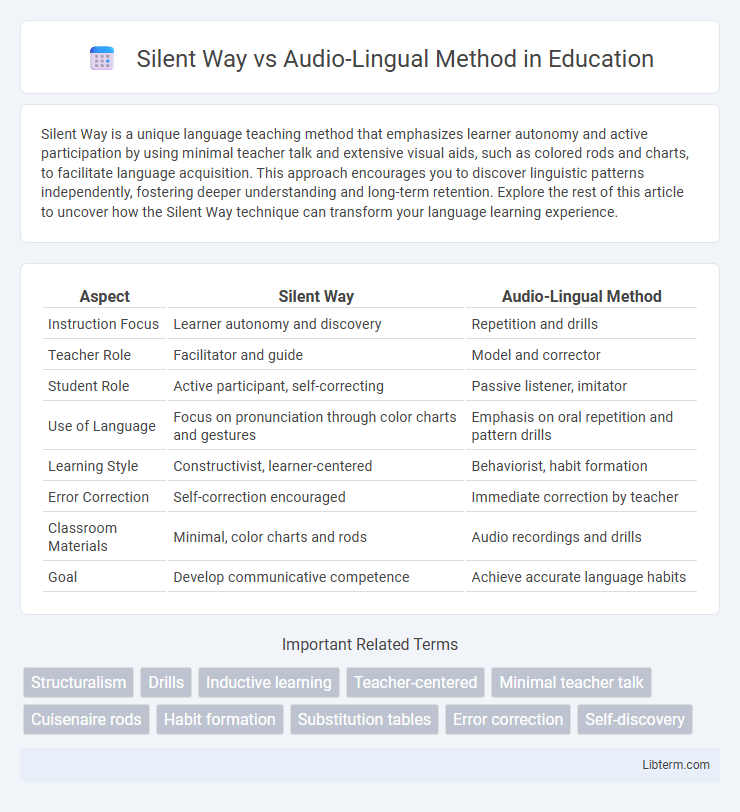Silent Way is a unique language teaching method that emphasizes learner autonomy and active participation by using minimal teacher talk and extensive visual aids, such as colored rods and charts, to facilitate language acquisition. This approach encourages you to discover linguistic patterns independently, fostering deeper understanding and long-term retention. Explore the rest of this article to uncover how the Silent Way technique can transform your language learning experience.
Table of Comparison
| Aspect | Silent Way | Audio-Lingual Method |
|---|---|---|
| Instruction Focus | Learner autonomy and discovery | Repetition and drills |
| Teacher Role | Facilitator and guide | Model and corrector |
| Student Role | Active participant, self-correcting | Passive listener, imitator |
| Use of Language | Focus on pronunciation through color charts and gestures | Emphasis on oral repetition and pattern drills |
| Learning Style | Constructivist, learner-centered | Behaviorist, habit formation |
| Error Correction | Self-correction encouraged | Immediate correction by teacher |
| Classroom Materials | Minimal, color charts and rods | Audio recordings and drills |
| Goal | Develop communicative competence | Achieve accurate language habits |
Introduction: Understanding Language Teaching Methods
The Silent Way emphasizes learner autonomy by minimizing teacher talk and using physical tools like colored rods to facilitate discovery learning, while the Audio-Lingual Method relies on repetitive drills and pattern practice to instill language habits through behaviorist principles. Both methods focus on developing communicative competence but differ in interaction styles and error correction approaches. Understanding these foundational distinctions helps educators select techniques that best suit learner needs and contexts.
Core Principles of the Silent Way
The Silent Way emphasizes learner autonomy and discovery through minimal teacher input, using tools like colored rods and sound charts to facilitate self-correction and internalization of language patterns. It prioritizes active student engagement by encouraging exploration, pronunciation accuracy, and problem-solving within authentic communicative contexts. This contrasts with the Audio-Lingual Method's focus on repetition, drills, and habit formation through teacher-led instruction.
Fundamental Features of the Audio-Lingual Method
The Audio-Lingual Method emphasizes repetitive drills, pattern practices, and mimicry to develop speaking and listening skills, relying heavily on habit formation through positive reinforcement. It prioritizes sentence-level structures and immediate correction to prevent errors from becoming ingrained while minimizing explicit grammar explanations. This method contrasts with the Silent Way, which encourages learner autonomy and discovery through problem-solving and minimal teacher intervention.
Teacher Roles: Silent Way vs Audio-Lingual Method
The teacher's role in the Silent Way method is primarily that of a facilitator and guide, encouraging learners to take responsibility for their own language acquisition through minimal intervention and strategic use of cues. In contrast, the Audio-Lingual Method positions the teacher as a model and controller, emphasizing repetition, drills, and immediate correction to reinforce accurate language patterns. While Silent Way promotes learner autonomy and cognitive engagement, Audio-Lingual Method relies on teacher-directed practice and systematic reinforcement.
Learner Engagement and Classroom Interaction
The Silent Way emphasizes learner autonomy and active problem-solving, fostering deep cognitive engagement through minimal teacher talk and maximizing student participation in discovering language rules. In contrast, the Audio-Lingual Method relies on repetitive drills and teacher-led modeling, promoting engagement through structured practice but often limiting spontaneous interaction. Classroom interaction in the Silent Way is learner-centered, encouraging meaningful output, whereas the Audio-Lingual Method features teacher-centered, behaviorist responses emphasizing habit formation.
Techniques and Classroom Activities Comparison
The Silent Way employs learner-centered activities emphasizing discovery and self-correction, using tools like Cuisenaire rods and color-coded pronunciation charts to foster autonomous language production. The Audio-Lingual Method relies heavily on repetitive drills and pattern practice, utilizing structured dialogues and mimicry to reinforce correct language habits through conditioned responses. While Silent Way techniques encourage exploration and internalization of rules, Audio-Lingual activities prioritize habit formation through extensive oral repetition and immediate error correction.
Use of Native Language in Both Methods
The Silent Way method minimizes the use of the native language, emphasizing learner autonomy through gestures, visuals, and problem-solving in the target language to promote natural acquisition. In contrast, the Audio-Lingual Method encourages repetitive drills and pattern practice primarily in the target language but occasionally uses the native language for clarification and explanation of grammatical structures. Both methods prioritize the target language, yet the Audio-Lingual Method permits limited native language use to facilitate comprehension, whereas the Silent Way restricts it to maximize immersion.
Advantages and Limitations of the Silent Way
The Silent Way method emphasizes learner autonomy by encouraging self-discovery and active problem-solving during language acquisition, fostering deeper internalization of linguistic structures. This approach promotes long-term retention and pronunciation accuracy through use of physical tools like Cuisenaire rods and color charts, yet it may overwhelm learners who require more immediate corrective feedback or structured guidance. Limitations include potential frustration from limited teacher input and challenges in group settings where individualized attention is harder to maintain.
Strengths and Weaknesses of the Audio-Lingual Method
The Audio-Lingual Method excels in reinforcing language structures through repetitive drills and pattern practice, promoting accurate pronunciation and automatic speech habits. However, its heavy reliance on rote memorization limits creativity and communicative spontaneity, often neglecting meaningful context and learner individuality. Critics also point out that this method may fail to develop deeper linguistic competence due to minimal emphasis on comprehension and critical thinking skills.
Choosing the Right Method: Factors to Consider
Choosing the right language teaching method depends on learner goals, context, and learning style. The Silent Way emphasizes learner autonomy and discovery through minimal teacher input, ideal for self-motivated students seeking deep understanding. The Audio-Lingual Method relies on repetition and drills, suited for beginners needing quick, structured practice in pronunciation and grammar patterns.
Silent Way Infographic

 libterm.com
libterm.com